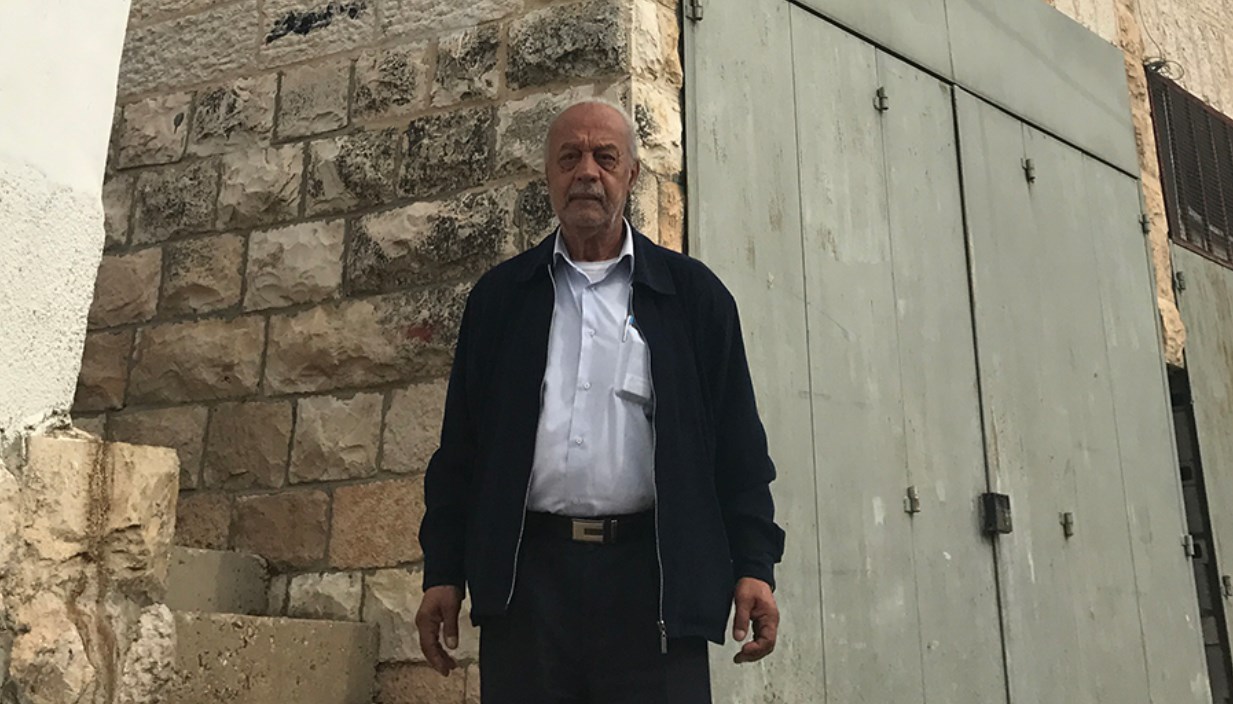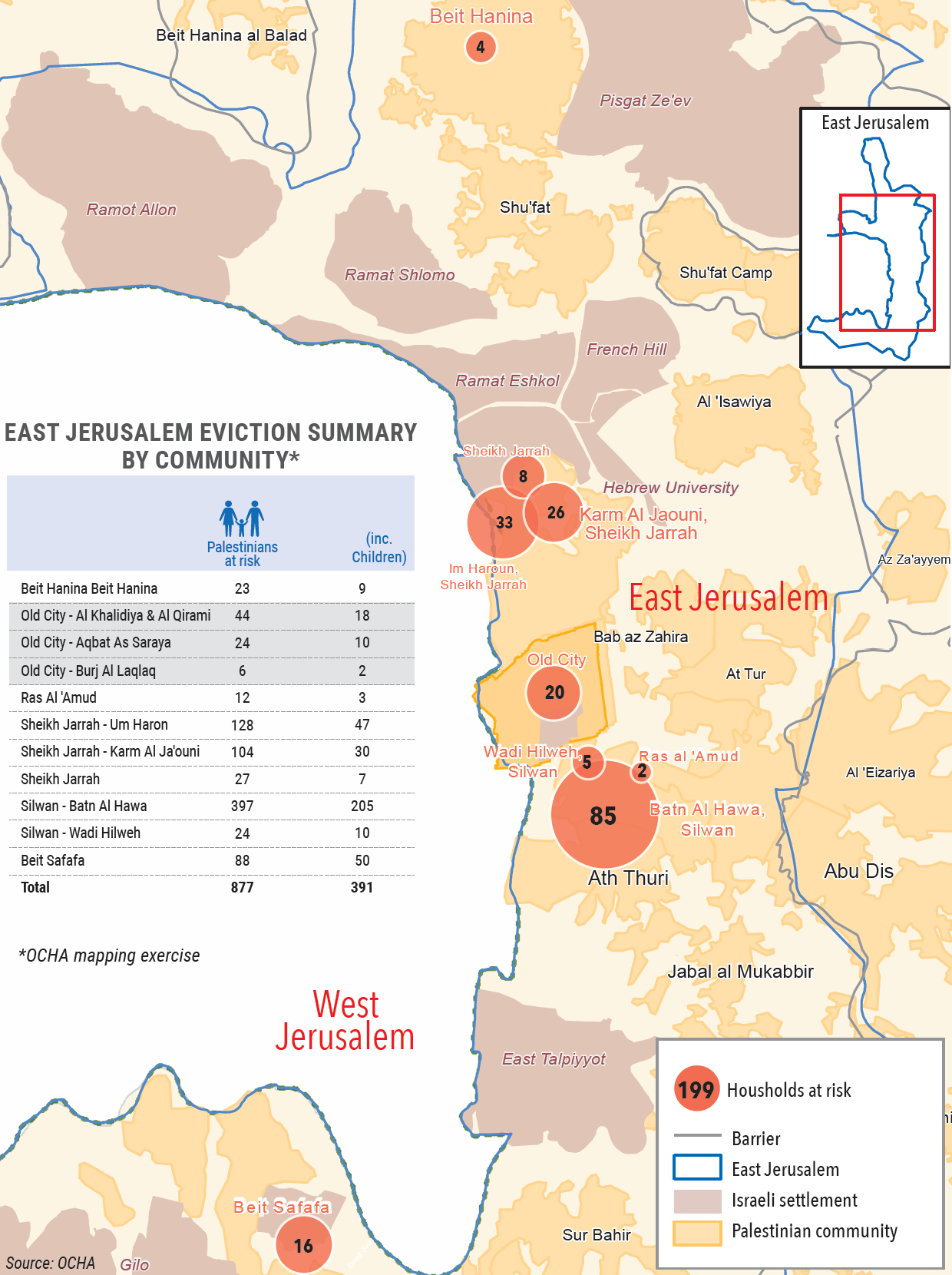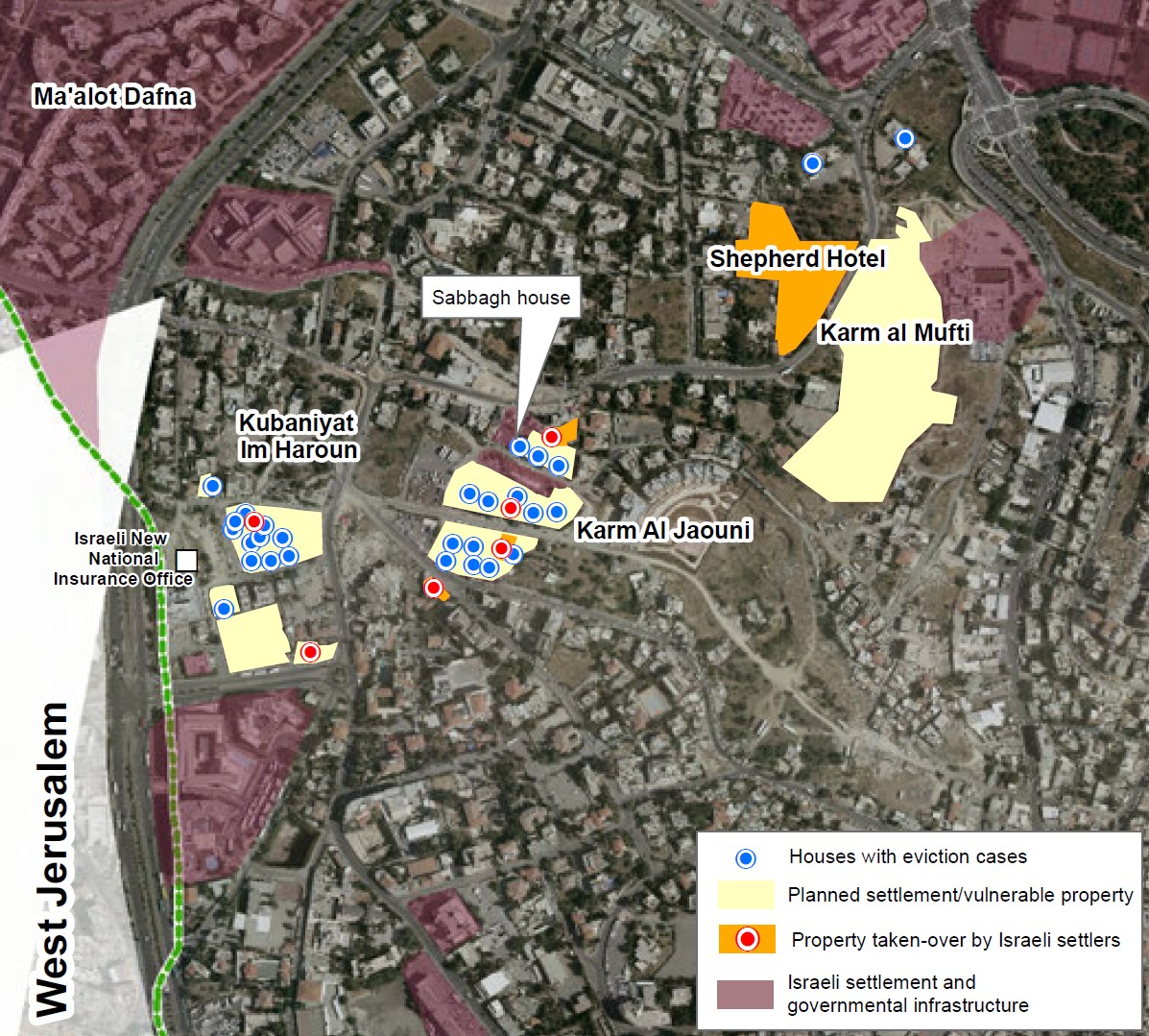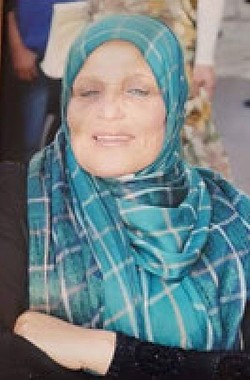Imminent eviction of Palestinian family in East Jerusalem
UN Humanitarian Coordinator calls for a halt to the eviction
Recent developments in East Jerusalem place an extended Palestinian refugee family from Sheikh Jarrah neighbourhood at risk of imminent forced eviction, following a lengthy legal struggle with an Israeli settler organization. Thirty-two members of the Sabbagh family currently reside in the family home, including six children; at least 19 additional people would be affected by the loss of their family home. This eviction may amount to a forcible transfer, which is a grave breach of the fourth Geneva Convention. Forced evictions contrary to international law also violate the right to adequate housing and the right to privacy, and may be incompatible with other human rights.[1]
On 15 November 2018, the Israeli Supreme Court dismissed a lawsuit filed by the Sabbagh and the neighbouring Hammad family, which had challenged a previous ruling that the land on which their homes are located is owned by two Israeli organizations.[2] On 3 January 2019, the Sabbagh family were notified by the Israeli Law Enforcement and Collection Authority that they had until 23 January to vacate their home, otherwise they would face eviction by force. Although the legal process is now exhausted, on 14 January, the authorities accepted a request to temporally delay the eviction on procedural grounds.

On 22 January, the UN Humanitarian Coordinator for the occupied Palestinian territory, Jamie McGoldrick, together with other UN officials and NGO partners, visited the Sabbagh family and called for a halt to the eviction.
Eviction through judicial means
The Sabbagh and Hammad families lost their family homes in Jaffa and Haifa respectively, as a result of the first Arab-Israeli war of 1948. In 1956, following an agreement between the Kingdom of Jordan and UNRWA, they were among 28 Palestine refugee families who were accommodated in a housing project in the Karm Al Jaouni area of Sheikh Jarrah. Prior to 1948, Jewish families had lived in Sheikh Jarrah but also fled in the context of the 1948 hostilities, and were subsequently compensated for their loss of their homes by the Israeli government.
Map 1 | East Jerusalem: Palestinians at risk of eviction

In 1967, Israel occupied and subsequently annexed East Jerusalem and in 1970 enacted the Legal and Administrative Matters Law, whereby Israelis may pursue claims to land and property allegedly owned by Jews in East Jerusalem prior to the establishment of the State of Israel in 1948. Palestine refugees, such as the Sabbagh family, are denied the right to reclaim land and property in what is now Israel, although their original home in Jaffa still stands.
Pursuant to the 1970 law, two Israeli organizations registered the land in Karm Al Jaouni in their name, based on Ottoman land documents, although the authenticity of these deeds is contested by the Palestinian families. These organizations in turn sold their rights in the area to Nahalat Shimon International, a private company registered in the United States, which has filed multiple lawsuits over the years to evict Palestinian families from Sheikh Jarrah.
Sheikh Jarrah: a centre for settler activity in East Jerusalem
In recent decades, Israeli settler organizations, with the support of the Israeli authorities, have taken control of properties within Palestinian neighbourhoods in East Jerusalem, and established a number of settlement compounds there.[4] In addition to Sheikh Jarrah, such settlements are concentrated in the Muslim and Christian quarters of the Old City, Silwan, At-Tur (Mount of Olives), Wadi Joz, Ras al ‘Amud, and Jabal al Mukabbir. A survey carried out by OCHA in 2016 indicated that there were 180 Palestinian households in East Jerusalem that had eviction cases filed against them, the majority initiated by settler organizations.[5] Since then, eight of these households, comprising 43 people, including 19 children, have been evicted from their homes in Beit Hanina, Silwan, the Old City and Sheikh Jarrah. New eviction cases have also been filed against Palestinian families since then; as of January 2019, it is estimated that 199 Palestinian households now have eviction cases filed against them, placing 877 people, including 391 children, at risk of displacement.
Sheikh Jarrah is a key target for settlement activity owing to its strategic proximity to the 1949 Armistice Line (Green Line) and to the Old City (see map 1).[6] The area is already the site of a number of Israeli government institutions, including the police and border police headquarters, the Ministry of Justice, and the new national insurance building. The Shepherd Hotel was expropriated by the Israeli authorities in 1967: a new settlement has been constructed on the site. On another plot of land in Sheikh Jarrah, the Amana Association, a settler organization, has constructed a new building and moved its headquarters there in August 2018, (see map 2).[7]
Fifty-five Palestinians, including 20 children, have already been forcibly evicted from their homes in the Karm Al Jaouni area by Israeli authorities since late 2008, without compensation or provision made for alternative housing, based on claims the properties had been owned by Jewish individuals or associations prior to 1948.[8] Their homes were immediately handed over to Israeli settlers, despite the buildings concerned having been constructed in 1956, subsequent to the period in which the Israeli organizations allegedly owned the land.
As of 31 January, a total of 26 households in Karm al Jaouni, comprising around 100 people (30 per cent of them children) have eviction cases filed against them by Israeli settler organizations, primarily based on alleged non-payment of outstanding rent, the building of extensions without the required building permits, and claims that the families are responsible for disturbances and threatening behaviour against their neighbours.
According to plans submitted to the Jerusalem municipality, the settlers ultimately intend to demolish all properties in Karm Al Jaouni to make way for a new Israeli settlement comprising at least 200 housing units.[9]
Settler organizations have also targeted Kubaniyat Im Haroun in the west of Sheikh Jarrah.[10] In September 2017, the Shamasneh family, who had lived in their home in this area since 1964 was evicted following a legal ruling and the house was handed over to Israeli settlers. In July 2017, the Jerusalem Regional Planning Committee discussed plans for new settlement units, including four plans for Kubaniyat Im Haroun. Two of the plans envisage the demolition of two residential buildings, placing 17 Palestinian households with 74 people at risk of displacement. Concurrently, individual eviction cases have been filed against 35 households in the area with a population of some 140 people of whom more than a third are children.[11]
Map 2 | Sheikh Jarrah: settlements and Palestinians at risk of displacement - 2019

Impact of eviction on Palestinian families
The evictions have grave physical, social, economic and emotional impact on the Palestinian families concerned. In addition to depriving the family of a home – its main asset and source of physical and economic security – evictions frequently result in disruption in livelihoods, increased poverty and a reduced standard of living.[12] The high legal fees families incur when defending their case in court further strain their already meagre financial resources. The impact on children is particularly devastating, including post-traumatic stress disorder, depression, anxiety and diminished academic achievement.
The establishment of settlement compounds in th heart of Palestinian areas also generate a coercive environment on the daily lives of Palestinians residing in the vicinity of these compounds, and creates pressure on them to leave. The main elements of this environment include increased tension, violence and arrests; restrictions on movement and access, particularly during Jewish holidays; and a reduction on privacy due to the presence of private security guards and surveillance cameras.[13]
The Status of East Jerusalem in international law
In 1967, Israel occupied East Jerusalem and unilaterally annexed it and surrounding areas to its territory. However, the annexation is not recognized by the international community, with the UN Security Council repeatedly declaring all legislative measures and actions taken by Israel to alter the character and status of Jerusalem to be null and void.[3]
Between refugee-hood and the imminent threat of forced eviction: the case of Hidaya Al Sabbagh
 "My name is Hidaya Al Sabbagh. I was born in Khan Yunis, in the Gaza Strip, in 1959. My 60th birthday is next month, on 24 February. My family was forced to flee from Jaffa to Gaza as a result of the 1948 war. I left Gaza in the mid-1980s and got married to Usama Al Sabbagh. Since then, I have been living in this house in Sheikh Jarrah. This has been my home for 34 years and it’s where I gave birth to my four sons and three daughters. This is where my mother-in-law lived with me, and was like a second mother to me until she passed away in the early 1990s, and where my husband passed away more than eight years ago.
"My name is Hidaya Al Sabbagh. I was born in Khan Yunis, in the Gaza Strip, in 1959. My 60th birthday is next month, on 24 February. My family was forced to flee from Jaffa to Gaza as a result of the 1948 war. I left Gaza in the mid-1980s and got married to Usama Al Sabbagh. Since then, I have been living in this house in Sheikh Jarrah. This has been my home for 34 years and it’s where I gave birth to my four sons and three daughters. This is where my mother-in-law lived with me, and was like a second mother to me until she passed away in the early 1990s, and where my husband passed away more than eight years ago.
"I have built a family here, having left my parents and two children from my former marriage in Gaza. The last time I was able to visit them was more than eight years ago. For 21 years, I worked at a kindergarten in Dar al Tifel al Arabi School, within walking distance from my house. Following several unsuccessful attempts, I was able to have my family unification application approved and received a Jerusalem identification card in 1991. Our house is modest, with two bedrooms, a toilet, two small sitting rooms, and a kitchen. We tried over the years to fix the water leakage and other issues despite our very limited financial means. Still, it is unimaginable to us that we would be forced to leave. I will stay and I will resist. But will we succeed or will our rights be lost?
"I suffer from diabetes and high blood pressure. I had an operation scheduled on 16 January to have platinum placed in my foot, but they couldn’t perform it due to my very high blood pressure. My health has been deteriorating due to the anxiety, sadness, and stress I live under all the time. If they re-schedule my operation, I’d have to stay in the hospital for a while and I don’t know how many days that would be. But I cannot leave my house, not now. I cannot go to the hospital, only to come back and find my family out on the street. What can I say? I am speechless."
[1] Statement by Jamie McGoldrick (Humanitarian Coordinator), Gwyn Lewis (Director of West Bank Operations for UNRWA), James Heenan (Head of OHCHR in the occupied Palestinian territory) and Kate O’Rourke (Country Director of the Norwegian Refugee Council), on 22 January
[2] The families’ appeal to have an extended panel of judges review the case was rejected on 10 January 2019.
[3] See, inter alia, Security Council resolutions 252, 267, 471, 476 and 478.
[4] Palestinian houses have been transferred to settler organizations by various means. In some cases, as is the case in Sheikh Jarrah, settlers have pursued court cases to evict the Palestinian residents, on the grounds that the land was owned by Jewish individuals or associations in East Jerusalem prior to 1948. In other cases, the Absentee Property Law of 1950 was applied: this law, which was devised to formalize the expropriation of the land and property of Palestinians who were expelled or fled during the 1948 Arab-Israeli war, has been applied to East Jerusalem since 1967. Settler organizations have also had some success at purchasing land and property directly from Palestinian owners, due to the economically depressed situation in many of the affected neighbourhoods. According to Israeli statistics, it is estimated that some 3,500 Israelis currently live in these settlements. Jerusalem Institute for Israel Studies, Statistical Yearbook of Jerusalem, 2018 Edition, Chapter III, Table III/5
[5] East Jerusalem: Palestinians at risk of eviction.
[6] See OCHA, The Case of Sheikh Jarrah: Updated Version, October 2010.
[7] Amana moves its Head Quarters to East Jerusalem, Ynet, 23 August 2018.
[8] This includes the Al Kurd family, which was evicted in November 2008; the Hanoun and Al Ghawi families, which were evicted in 2002 and, having reclaimed their homes in 2006, again in August 2009; and the Rifqa Al Kurd family, which lost part of its home to the settler groups in November 2009. In addition, a fourth home was already taken over by settlers in 1967.
[9] This includes at least 200 residential units according to Town Plan Scheme 12705, which was submitted to the Jerusalem Local Planning and Building Committee in January 2008. See Seizing Control of Space in East Jerusalem (M. Margalit, June 2010) and Evictions and Settlement Plans in Sheikh Jarrah: the Case of Shimon HaTzadik (Ir Amim, June 2009).
[10] Similar to the situation in Karm Al Jaouni, there has been an ongoing ownership dispute in this area between the Palestinian residents and the Israeli Administrator General acting on behalf of Israeli individuals, who claim to have owned the land before 1948, and other Jewish owners. The majority of Palestinian residents in this area are refugees living in generally dilapidated housing conditions with more than one nuclear family living in each house. A protracted legal battle came to an end in September 2010 when the Israeli Supreme Court ruled in favour of the Administrator General and other Jewish individuals. The Administrator General is the legal entity that serves as a trustee of any property in East Jerusalem which, prior to Israel’s occupation and annexation of the area in 1967, was held by the Jordanian Custodian of Enemy Property.
[11] There are also plans for a nine-storey building to house the Or Shameach Yeshiva campus (also known as the Glassman campus) and an additional six-storey office building. Although these plans target empty plots of land and do not entail evictions, they will further change the demographic character of the neighbourhood and create a contiguous belt of settlement units and Israeli government buildings throughout Sheikh Jarrah.
[12] See also: Norwegian Refugee Council, The Economic Impact of Displacement, April 2015.
[13] See OCHA: Humanitarian impact of settlements in Palestinian neighbourhoods of East Jerusalem: the coercive environment.










